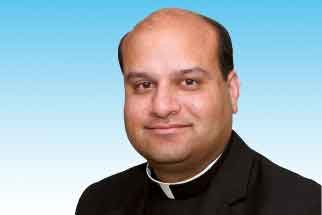
Fr. Raymond J. de Souza
Artist has terrific theological insight
At the general audience of Nov. 20, the work of Canadian sculptor Timothy Schmalz was presented to Pope Francis. The sculpture, Jesus the Homeless, is a striking image of a homeless person sleeping on a park bench. With the face wrapped in a heavy blanket against the cold, it is impossible to tell who it might be. Only the feet are exposed and then it becomes clear who it is — there are the marks of the nails. It is the crucified one, Jesus Christ. There is space on the bench for someone to sit down alongside the sleeping, homeless Jesus. One could well imagine the Holy Father, with his heart for the poor and the suffering, sitting alongside someone on that bench. In St. Peter’s Square, Pope Francis beheld the statue and then blessed it.
The world was present for Christ’s birth
KINGSTON, ONT. - Local Catholic Tony Vella had an effective evangelizing idea. How to remind local schoolchildren about the birth of Jesus amid the commercial clutter of the season? The St. Paul the Apostle parishioner thought that the best way to remind children about Jesus was to show them, well, Jesus.
New look at New World pope
It’s been a long time since the Church has had to learn about a new pope. The shocking election of 1978 meant that Catholics the world over scrambled to discover who this Karol Wojytla from behind the Iron Curtain was. But the election of 2005 gave us a man already well-known to the world for more than a quarter century, Joseph Ratzinger. So with the election of Jorge Mario Bergoglio as Pope Francis, people are fascinated with a hitherto unknown man for the first time in more than three decades.
A glimpse of today’s Church
One of the lovelier aspects of Catholic culture is the love that Catholics have for their priests. Most priests have many stories of how complete strangers have shown special warmth and affection upon seeing the Roman collar. As for one’s own portion of the flock, parish priests and chaplains know how eager Catholics are to love their priests.
The gift of the Lateran Basilica
Nov. 9 is a rather obscure feast on the liturgical calendar — the feast of the dedication of the Basilica of St. John Lateran. Obscure, but most important. A year when we are praying for a new Pope is a good occasion to revisit its significance.
Our fascination with death
At the heart of the liturgical year are the great feasts of Christmas and Easter, the feast of eternal life becoming earthly in a new baby, and the feast of earthly life becoming eternal in the Resurrection. The Christian calendar hangs upon the great feasts of life. Yet notwithstanding the principal feasts, the opening days of November, the month in which we pray for the dead, are a direct answer the Church gives to the mystery of death. All Saints Day celebrates those who have died and are already enjoying the life of beatitude in heaven. All Souls Day prays for those who have died and, while still being purified in purgatory, will one day be in heaven. The Church does not ask us to look away from death. To the contrary, in November she forces us to look straight at it.
Sexual revolution on New York streets
History with a sacred heart
Last Sunday, on the anniversary of the final apparition of the Blessed Virgin Mary at Fatima, the Holy Father consecrated the entire world to her Immaculate Heart, in the presence of the original statue of Our Lady of Fatima, brought to Rome from the Portuguese shrine.
Secular Quebec and the crucifix
QUEBEC CITY - Last week the National Assembly here was the scene of a rather unlovely protest, with topless women of a feminist bent protesting the presence of the crucifix over the Speaker’s chair in the chamber. Stripping off in the presence of the province’s first female premier, the protesters had written their slogans on their naked torsos, loosely translated as “heritage belongs in a museum.” The reference was to the Parti Québécois position that the crucifix will remain in the National Assembly, even while “conspicuous” religious symbols are banned from the public sector under the proposed “Charter of Quebec Values.” The crucifix is not a religious symbol, the government maintains, but a manifestation of Quebec’s “cultural heritage.”
Meet the new faith, same as the old faith
I found myself unwittingly joining in a fun new Catholic game last week. Ever since Pope Francis’ interview with La Civilta Cattolica was published in Jesuit journals around the world, there has been both within and without the Church great huzzahs that under the new Holy Father everything will be, well, new, new, new! So here and there more knowledgeable Catholics than one would find at, say The New York Times, or for that matter, at some of those same Jesuit publications, have highlighted this or that revolutionary quotation from the interview, only to reveal that it in fact was said five years ago by Pope Benedict XVI.

